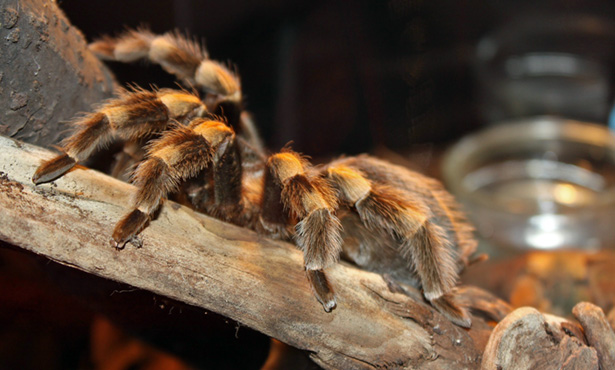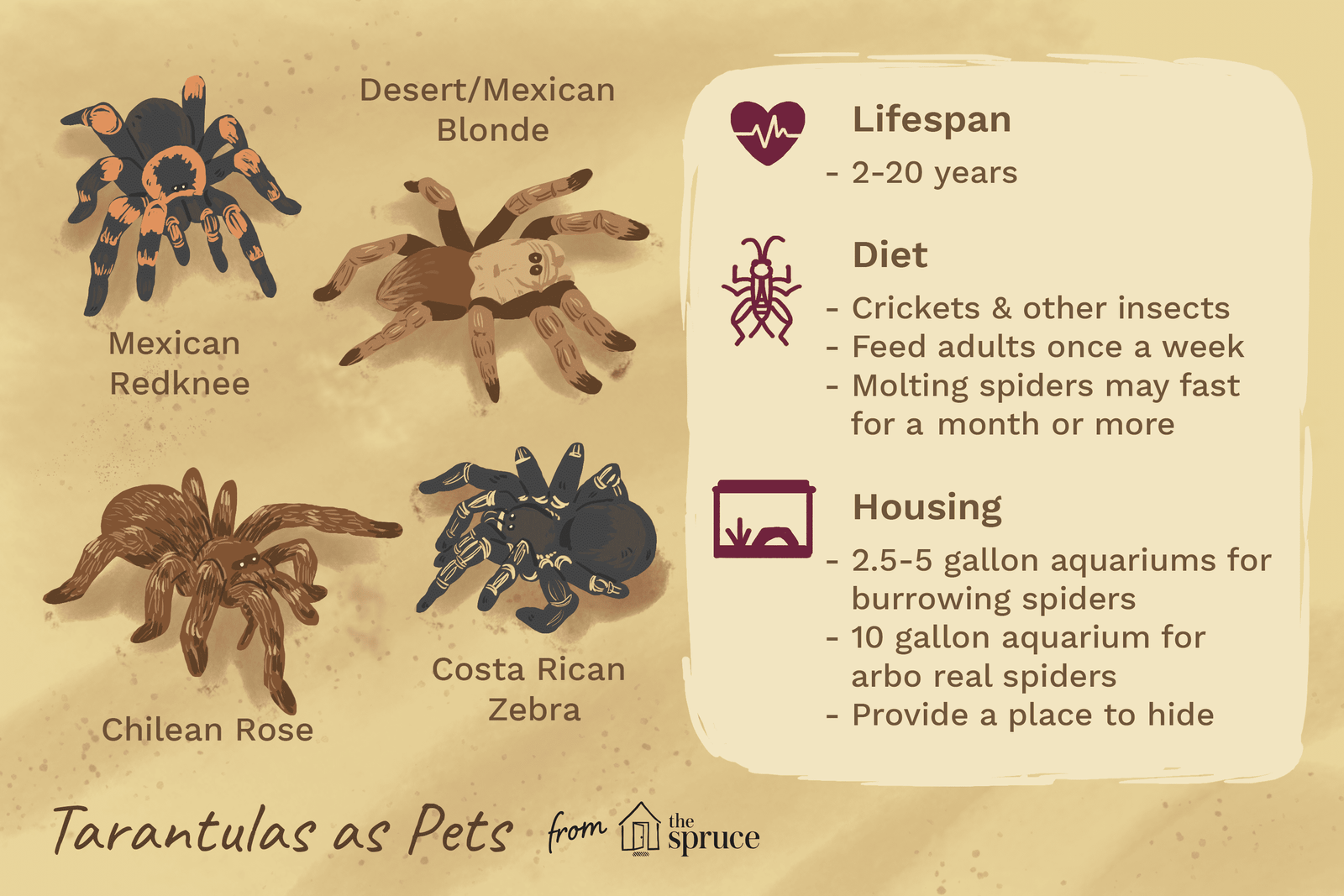To care for a pet tarantula, feed them a diet of crickets supplemented with other insects and provide fresh, clean water in a shallow bowl. Tarantulas should be housed in a quiet area with a tight-fitting and locking screen top to prevent escape.
While tarantulas are not social creatures, some may tolerate handling, but it is best to minimize stress by handling them as little as possible. Overall, tarantulas are fairly straightforward to maintain and make a good choice for those who want a low-maintenance pet.
Expect to spend a few hours each week on feedings and cleaning.
:strip_icc()/Tarantula-GettyImages-543229403-587a546b5f9b584db3d5f382.jpg)
Credit: www.thesprucepets.com
Introduction To Pet Tarantulas
Many people are fascinated by exotic pets, and one unique option that often captures attention is the pet tarantula. These eight-legged creatures may seem intimidating at first, but with proper care and understanding, they can make fascinating and low-maintenance companions. In this article, we’ll explore the benefits of owning a tarantula, common types of pet tarantulas, and the unique challenges that come with their care.
Benefits Of Owning A Tarantula
Owning a tarantula can bring several unique advantages to pet owners. Firstly, tarantulas are often considered low-maintenance pets, making them suitable for busy individuals or those who don’t have a lot of experience with pet care. They require minimal attention and can be easily fed with pre-packaged insects, such as crickets or mealworms. Additionally, tarantulas are quiet creatures, making them great for individuals who prefer a calm and serene environment. Their fascinating behavior and unique appearance also provide a source of intrigue and entertainment.
Common Types Of Pet Tarantulas
There are several common types of pet tarantulas, each with its own distinct characteristics. Some popular choices include:
| Tarantula Type | Description |
|---|---|
| Avicularia avicularia | Known as the “Curlyhair tarantula,” this species is recognized for its beautiful curly hairs and calm temperament. |
| Rose hair tarantula | One of the most popular pet tarantulas, the Rose hair tarantula, has a docile temperament and is known for its striking coloring. |
| Texas brown tarantula | The Texas brown tarantula is a hardy species that thrives in a wide range of conditions and is suitable for beginners. |
| Grammostola pulchra | Also known as the “Brazilian black tarantula,” this species is highly sought after for its velvety black appearance and calm disposition. |
Challenges Of Tarantula Care
While tarantulas can be relatively low-maintenance pets, they do come with their unique set of challenges. One of the main challenges is their defense mechanisms, which can complicate their overall care. Tarantulas have urticating hairs that they can kick off when they feel threatened, causing irritation to the skin and respiratory system. Therefore, handling should be kept to a minimum to avoid stress for the spider and potential harm to the owner. Another challenge is creating the right environment in their enclosure. Tarantulas require specific temperature and humidity levels, as well as appropriate substrate for burrowing or creating webs. Understanding and meeting these requirements is vital to maintaining a healthy and content tarantula.

Credit: vetmed.illinois.edu
Creating The Ideal Habitat
Learn how to provide the ideal habitat for your pet tarantula. From choosing the right enclosure to feeding and cleaning, this guide will help you care for your tarantula with ease.
Selecting The Right Enclosure
When it comes to creating the ideal habitat for your pet tarantula, selecting the right enclosure is of utmost importance. Tarantulas require a secure and spacious environment to thrive. An appropriate enclosure should have enough space for the tarantula to move around comfortably, while also preventing any potential escapes.
To ensure the safety of your pet, choose an enclosure made of glass or clear plastic. Avoid enclosures with mesh or screen walls, as these can easily be damaged or manipulated by your tarantula. A tight-fitting and locking screen top is essential to prevent escapes and to maintain proper ventilation.
Choosing The Suitable Substrate
The substrate you provide in your tarantula’s enclosure plays a crucial role in maintaining a healthy and comfortable habitat. The right substrate should mimic the tarantula’s natural environment while providing proper moisture retention.
Opt for a substrate that is free of chemicals and pesticides, such as coconut fiber or peat moss. These substrates not only provide a soft and burrowable surface for your tarantula, but they also retain moisture well, ensuring the proper humidity levels are maintained.
Providing Adequate Temperature And Humidity Levels
In addition to a suitable enclosure and substrate, it is vital to provide your pet tarantula with the right temperature and humidity levels. Tarantulas are ectothermic creatures, meaning they rely on their environment to regulate their body temperature.
Keep the enclosure temperature between 75-85 degrees Fahrenheit (24-29 degrees Celsius) during the day and slightly cooler at night. To achieve optimal humidity levels, mist the enclosure regularly using a sprayer or place a shallow water dish that your tarantula can access for drinking and increasing humidity.
Remember to monitor the temperature and humidity levels using appropriate equipment, such as a thermometer and a hygrometer, to ensure they remain within the desired range.
Feeding And General Care
Caring for a pet tarantula is fairly straightforward, although their defense mechanisms can complicate things. They are a good choice for those looking for a low-maintenance pet, requiring only a few hours a week for feeding and cleaning. Be sure to provide a quiet and stress-free environment in their enclosure.
Recommended Diet For Tarantulas
Tarantulas are carnivorous creatures that primarily feed on insects and other small invertebrates. In captivity, the recommended diet for tarantulas consists mainly of live prey. The most common food options include crickets, mealworms, and dubia roaches. These prey items provide the necessary nutrients to keep your pet tarantula healthy and thriving. It is important to ensure that the feeder insects are properly gut-loaded, meaning they are fed a nutritious diet before being offered to the tarantula. This ensures that your tarantula receives all the essential vitamins and minerals it needs. Additionally, offering a variety of prey items can help prevent dietary deficiencies and keep your tarantula satisfied.Establishing A Feeding Schedule
When it comes to feeding your pet tarantula, establishing a regular schedule is crucial. Adult tarantulas usually require a meal once every one to two weeks, while younger spiders may need more frequent feedings. It is essential to monitor your tarantula’s appetite and adjust the feeding schedule accordingly. Remember, tarantulas have slow metabolisms, so overfeeding can lead to obesity and other related health issues. To ensure a successful feeding session, it’s best to offer prey items that are smaller in size compared to the tarantula’s body. This prevents any potential injuries during the feeding process.Maintaining A Clean Environment
Maintaining a clean and hygienic environment is vital for the overall well-being of your pet tarantula. A clean enclosure helps prevent the buildup of waste, parasites, and bacteria, minimizing the risk of infections and diseases. Regularly remove any uneaten prey items and fecal matter from the enclosure to keep it tidy. Depending on your tarantula’s species and size, a complete enclosure cleaning may be necessary every few months. During this process, gently transfer your tarantula to a temporary holding container and clean the enclosure thoroughly with a pet-safe disinfectant. Rinse the enclosure with water and allow it to air dry completely before reintroducing your tarantula.Handling Tarantulas With Caution
Handling tarantulas should be approached with caution and care. While some tarantula species are docile and exhibit less aggressive behavior, it’s important to remember that they are not social creatures and do not seek out human interaction. It is not accurate to say that they enjoy being handled. To minimize stress for your pet tarantula, it is best to handle them as little as possible. When handling is necessary, make sure to wear protective gloves to avoid accidental bites or stings. Always be gentle and avoid any sudden movements that may startle the tarantula. Gradually introduce your hand into the enclosure and allow the tarantula to crawl onto it voluntarily. Remember to wash your hands thoroughly before and after handling your tarantula to prevent the transfer of any potential contaminants.
Credit: m.youtube.com
Frequently Asked Questions For How To Care For A Pet Tarantula
Are Pet Tarantulas Easy To Take Care Of?
While tarantulas have defense mechanisms that can complicate their care, they are fairly straightforward to maintain. They are a good choice for those who want a low-maintenance and quiet pet. Expect to spend a few hours each week on feeding and cleaning.
How Often Do You Feed A Pet Tarantula?
Feed your pet tarantula a diet of crickets supplemented with other insects like mealworms, super worms, and roaches. Larger tarantulas can even eat small vertebrates. Feed them once or twice a week, adjusting the frequency depending on their appetite and growth.
What Do Tarantulas Need In Their Enclosure?
In tarantula enclosures, they need a quiet area with low light. Use a tight fitting screen top to prevent escape.
Do Tarantulas Like To Be Handled?
Tarantulas do not enjoy being handled as they are not social creatures and do not seek human interaction. It is best to handle tarantulas as little as possible to minimize stress for the spider.
Conclusion
Taking care of a pet tarantula may seem intimidating, but it doesn’t have to be. While tarantulas may have their unique defense mechanisms, they are still relatively easy to maintain. They make great pets for those who prefer a low-maintenance and quiet companion.
With a few hours each week dedicated to feedings and cleaning, you can provide a suitable environment for your pet tarantula. Remember to give them a quiet and stress-free enclosure, along with fresh water always available. By following these simple steps, you can ensure the well-being of your pet tarantula and enjoy their unique presence in your home.

